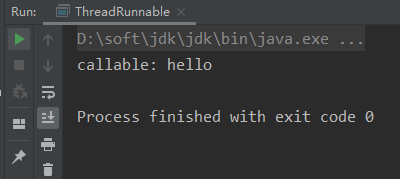一:Runnable和Callable的区别
最本质的区别在于,Runnable没有返回结果,Callable会有一个返回结果,返回结果是泛型,可以自己定义。举例子说明:
public class ThreadRunnable {
public static void main(String[] args) throws ExecutionException, InterruptedException {
MyRunnable runnable = new MyRunnable();
new Thread(runnable).start();
MyCallable callable = new MyCallable();
FutureTask task = new FutureTask(callable);
new Thread(task).start();
System.out.println("callable: " + task.get());
}
}
class MyRunnable implements Runnable {
@Override
public void run() {
return;
}
}
class MyCallable implements Callable<String> {
@Override
public String call() throws Exception {
return "hello";
}
} 
上述例子中可以看到,callable可以定义一个返回结果,通过FutureTask的get方法可以获得线程执行后的结果(阻塞等待结果)。
源码查看:
/**
* Allocates a new {@code Thread} object. This constructor has the same
* effect as {@linkplain #Thread(ThreadGroup,Runnable,String) Thread}
* {@code (null, target, gname)}, where {@code gname} is a newly generated
* name. Automatically generated names are of the form
* {@code "Thread-"+}<i>n</i>, where <i>n</i> is an integer.
*
* @param target
* the object whose {@code run} method is invoked when this thread
* is started. If {@code null}, this classes {@code run} method does
* nothing.
*/
public Thread(Runnable target) {
init(null, target, "Thread-" + nextThreadNum(), 0);
}可以看到,Thread里可以放Runnable,但是不可以放callable,继续查看FutureTask:
public class FutureTask<V> implements RunnableFuture<V> {
/*
* Revision notes: This differs from previous versions of this
* class that relied on AbstractQueuedSynchronizer, mainly to
* avoid surprising users about retaining interrupt status during
* cancellation races. Sync control in the current design relies
* on a "state" field updated via CAS to track completion, along
* with a simple Treiber stack to hold waiting threads.
*
* Style note: As usual, we bypass overhead of using
* AtomicXFieldUpdaters and instead directly use Unsafe intrinsics.
*/
/**
* The run state of this task, initially NEW. The run state
* transitions to a terminal state only in methods set,
* setException, and cancel. During completion, state may take on
* transient values of COMPLETING (while outcome is being set) or
* INTERRUPTING (only while interrupting the runner to satisfy a
* cancel(true)). Transitions from these intermediate to final
* states use cheaper ordered/lazy writes because values are unique
* and cannot be further modified.
*
* Possible state transitions:
* NEW -> COMPLETING -> NORMAL
* NEW -> COMPLETING -> EXCEPTIONAL
* NEW -> CANCELLED
* NEW -> INTERRUPTING -> INTERRUPTED
*/
private volatile int state;
private static final int NEW = 0;
private static final int COMPLETING = 1;
private static final int NORMAL = 2;
private static final int EXCEPTIONAL = 3;
private static final int CANCELLED = 4;
private static final int INTERRUPTING = 5;
private static final int INTERRUPTED = 6;
/** The underlying callable; nulled out after running */
private Callable<V> callable;
/** The result to return or exception to throw from get() */
private Object outcome; // non-volatile, protected by state reads/writes
/** The thread running the callable; CASed during run() */
private volatile Thread runner;
/** Treiber stack of waiting threads */
private volatile WaitNode waiters;
}/**
* A {@link Future} that is {@link Runnable}. Successful execution of
* the {@code run} method causes completion of the {@code Future}
* and allows access to its results.
* @see FutureTask
* @see Executor
* @since 1.6
* @author Doug Lea
* @param <V> The result type returned by this Future's {@code get} method
*/
public interface RunnableFuture<V> extends Runnable, Future<V> {
/**
* Sets this Future to the result of its computation
* unless it has been cancelled.
*/
void run();
}上面的代码看到了:最终FutureTask也是实现了Runnable。
二:自定义一个FutureTask类
FutureTask的get可以阻塞等待结果,那么在写之前思考下,需要哪些步骤?

步骤如下:
1:需要去重写继承的Runnable接口的run方法;
2:需要一个callable变量,用来执行call()方法;
3:需要一个泛型的变量,用来存放结果;
4:还需要一个队列,用来存放那些阻塞还未返回结果的线程;
5:需要一个标志,判断线程是否执行完,可以返回结果;
6:最后,需要一个获取结果的方法。
代码实现如下,有注释可以方便查看:
public class ThreadFutureTask<T> implements Runnable {
//判断线程有没有执行完,可以返回结果
public static volatile boolean isEnding = false;
//callable对象
public Callable<T> callable;
//线程执行后的结果
public volatile T result;
//队列,用于存放未执行完的线程,即阻塞的线程,放到队列中
public LinkedBlockingDeque<Thread> waiter = new LinkedBlockingDeque<>();
//构造函数
public ThreadFutureTask(Callable<T> callable) {
this.callable = callable;
}
//实现Runnable的run方法
@Override
public void run() {
try {
//获取callable执行的结果
result = callable.call();
} catch (Exception e) {
e.printStackTrace();
} finally {
//最后,不管有没有执行完,都结束获取结果
isEnding = true;
}
//把队列中阻塞的线程,唤醒,否则获取不到结果
while (true) {
Thread thread = waiter.poll();
//要是队列中没有线程在挂起,就直接返回
if (thread == null) {
break;
}
//唤醒挂起的线程
LockSupport.unpark(thread);
}
}
//获取结果的方法
public T get() {
//如果线程执行完了,就获取结果,否则就挂起
if (!isEnding) {
waiter.offer(Thread.currentThread());
}
//让线程挂起
while (!isEnding) {
LockSupport.park();
}
//返回结果
return result;
}
}然后再去上面的runnable和callable区别的测试类里测试一下:
public static void main(String[] args) throws ExecutionException, InterruptedException {
// MyRunnable runnable = new MyRunnable();
// new Thread(runnable).start();
MyCallable callable = new MyCallable();
ThreadFutureTask task = new ThreadFutureTask(callable);
// FutureTask task = new FutureTask(callable);
new Thread(task).start();
System.out.println("callable: " + task.get());
}返回结果如下:

可以看到,返回结果和FutureTask一样,这样就实现了FutureTask的功能。
三:CountDownLatch
CountDownLatch是一个同步工具类,它是让一个或者多个线程等待,直到其他线程执行完再执行;CountDownLatch是通过倒计数器来实现的,它的初始值就是线程的数量,每当一个线程执行完毕,计数器就减一,直到减到0,输出所有线程执行的结果,等待的线程就可以恢复继续执行。
public static AtomicLong num = new AtomicLong(0);
public static void main(String[] args) throws InterruptedException {
//倒计时计数器,
CountDownLatch latch = new CountDownLatch(10);
for (int i=0; i<10; i++) {
new Thread(() -> {
for (int j=0; j<100000; j++) {
num.getAndIncrement();
}
//计数器减1
latch.countDown();
}).start();
}
//打开开关
latch.await();
System.out.println(num.get());
}四:Semaphore
Semaphore是一个计数信号量,可以控制访问资源的线程数量,也就是说,它是一个可以控制并发的共享锁,也就是限流。
public static void main(String[] args) {
//初始值就是可以通过的数量
Semaphore semaphore = new Semaphore(2);
for (int i=0; i<100; i++) {
new Thread(() -> {
try {
//拿到通道
semaphore.acquire();
System.out.println("开始通过桥梁。。。。");
} catch (InterruptedException e) {
e.printStackTrace();
}
test("222");
//执行完释放通道
semaphore.release();
}).start();
}
}
public static void test(String name) {
System.out.println(name + "成功通过");
LockSupport.parkNanos(1000 * 1000 * 1000 * 3000);
}五:CyclicBarrier
CyclicBarrier循环栅栏,可以循环利用的屏障,它的作用就是让线程都等待完成后才会再去执行。
比如:去游乐园做摩天轮,假设只能上齐四个人才允许启动,那么再没有上齐之前,其他人就在等待。
public static void main(String[] args) {
//初始值就是每次可以处理的数量
CyclicBarrier barrier = new CyclicBarrier(2);
for (int i=0; i<100; i++) {
new Thread(() -> {
try {
//等待
barrier.await();
System.out.println("摩天轮启动了。。。。");
} catch (InterruptedException | BrokenBarrierException e) {
e.printStackTrace();
}
}).start();
}
}好了,到此,本篇文章就结束了。





















 226
226











 被折叠的 条评论
为什么被折叠?
被折叠的 条评论
为什么被折叠?








